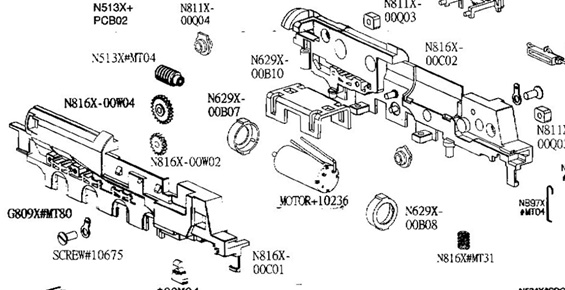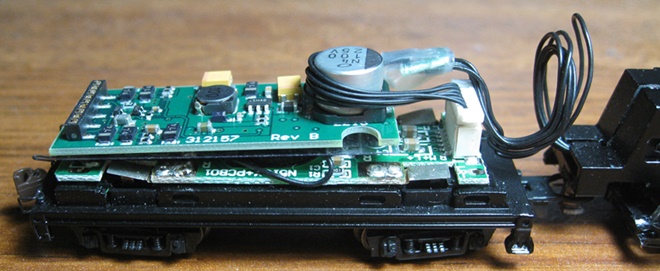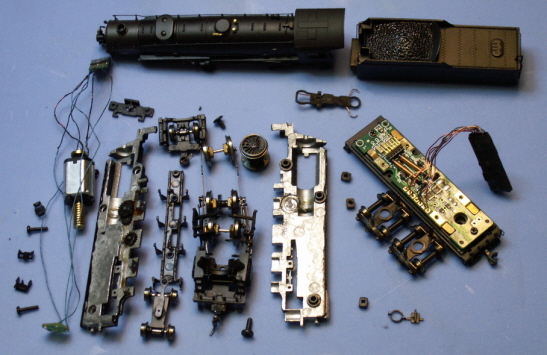Light Mountain -

Heavy Mountain -

Light Mountain -

Heavy Mountain -

Introduced: 2003 (Light 4-8-2), 2007 (Heavy 4-8-2), 2012 (Revised Light 4-8-2), and 2019 (DCC-Sound Light 4-8-2)
As noted above, Bachmann has produced four somewhat different 4-8-2 models. All are gorgeous pieces of modeling, featuring extremely fine paint and detailing. However, although the four models share many mechanical similarities, performance between the four differs significantly (more on that shortly).
The 2003 version of the light mountain was Bachmann's first new steam locomotive release to follow their highly regarded 2-8-0 Consolidation (2001). Not surprisingly, the two models share a very similar chassis / mechanism design -

The chassis is all-metal, split-frame and fairly hefty. The motor is an open-sided / skew-wound 5-poler. Six of the eight drivers provide pickup (the third set of drivers from the front being equipped with traction tires). Additionally, pickup is provided by all eight tender wheels (with current transferred to the locomotive via a pair of stiff wires on the plastic drawbar). Only the center pair of driver sets are geared (the other two driversets being turned solely by the running gear). All gearing is plastic. A PC board with a directional headlight is mounted in the front of the locomotive chassis (there is no backup light). The pilot coupler is a dummy (non-operational) knuckle. A Rapido-style replacement for the pilot coupler is included in the box should you want to go that route. The tender coupler is a chassis-mounted Rapido. The wheel flanges are low-profile, so no problems on Code-55 track. Uncoupling the tender from the engine is blessedly simple. Simply twist the tender 90 degrees and the drawbar pops right off.
These first version light mountains tend to be billed as "DCC-Ready", but decoder installation isn't as simple as dropping in a PC board replacement or inserting an NMRA-style plug. What Bachmann has done is provided a removeable weight on the chassis where a decoder can be placed, and then provided wiring leads for track power, motor control, and lighting control all in the same general vicinity.
Bachmann's original light mountain is a very pretty looking locomotive that, unfortunately, doesn't quite cut it in the performance department. On the plus side, it runs relatively smoothly and quietly, and responds very nicely to the throttle. It can handle 11"-radius curves without difficulty (although any sharper than that and the pilot truck will eventually derail). However, it's when you actually try running the thing around your layout with some rolling stock in tow that the problems start to surface. Despite the traction tires, pulling power is anemic (at best). Any more than two or three heavyweight passenger cars and this thing is spinning its wheels.
I have been told that the problem with the traction tires is that they don't contact the rails properly (owing to some sort of flaw in the design or manufacture of the frame). This can (in theory) be addressed by removing the bottom plate and rotating the axle bearings on the traction driver wheelset in hopes of finding a better fit. And failing that, you can also pull out the traction driver set entirely and try installing shims in the pockets between the frame and the driver bearings to get more downward pressure on the drivers. I spent some time trying out some of these suggestions, but didn't have any luck (quite the opposite actually, the thing barely ran until I put everything back the way it was to start with). Another reported solution is to replace the stock traction tires with something thicker (Fleischmanns, for example).
So, ultimately these first edition light mountains are (as delivered) total Hobby Shop Babies - they look great and run impressively on the ol' test track, but get them home and they become very expensive paperweights.
Bachmann released a revised (and much improved) version of their light 4-8-2 in 2012. New features include a DCC-Ready tender with wiring for motor and lighting control running from the tender PC board to the engine. Numbered contacts on the PC board show where to solder decoder wiring should you wish to convert to DCC. The tender coupler is a chassis-mounted E-Z Mate -

Although the locomotive chassis appears to be the same as the one used on the first version, pulling power is (for whatever reason) greatly increased over the original release. Maybe Bachmann simply tightened up the tolerances, but whatever the case, this new version can comfortably haul fifteen 40' freight cars on level track. In fact, it's capable of pulling a lot more than that if your trackwork is spot-on perfect. Unfortunately, they do remain a bit finicky about minor dips in the track (where they tend to get hung up and spin their wheels when pulling twenty or more cars). Still and all, definitely a major improvement over the first version.
Bachmann released an all new DCC-Sound version of their light mountain in 2019. As pictured below, the internals were completely redesigned (as compared to the previous two versions). The locomotive chassis is all metal and split-frame (the locomotive and tender shells are both plastic). A plastic clip on the top of the chassis holds the motor in place. A couple of pieces of electrical tape help keep all of the wiring from causing trouble. Black wires from the PC board in the tender transfer current for track power, lighting control and motor control to the headlight LED board. Blue and red wires transfer current from the LED board back to the motor. Additional black wires screwed to each side of the chassis transfer track power back to the tender (which would seem to render the stiff metal wires on the drawbar rather redundant, but whatever). The headlight is directional insofar as it gets brighter when the locomotive is moving in the forward direction -

The motor is a round can-style jobber (and presumably coreless). The brass worm is attached directly to the motor driveshaft. There are no flywheels -

Six of the eight drivers provide pickup (the #3 drivers being equipped with traction tires). The pilot and trailing trucks are electrically neutral. The trailing truck is sprung, whereas the pilot truck is not. The pilot coupler is a dummy (non-operational) knuckle. Wheels are blackened and low-profile (no problems on Atlas Code-55 rails) -

Two of the four driver axles are geared and all gearing is black plastic. The axles spin inside of brass bearing blocks that slot into cutouts in the chassis -

The tender appears to be the same one that Bachmann used on their DCC-Sound 2-8-0 (2018). A Soundtraxx "Economi" DCC-Sound decoder comes plugged into a 9-pin connector on the tender PC board. The wiring to/from the locomotive is attached to a harness that plugs into the main PC board. There is no backup light. The tender coupler is a chassis-mounted automatic/magnetic Bachmann E-Z Mate (Rapido-style couplers for the pilot and tender are included in the box should you want to go that route) -

All eight tender wheels provide pickup (by way of low-friction axle cups). Current is transferred from the tender trucks to the tender by way of sticky-uppy wipers that rub up against flexible contacts on the tender PC board. Locomotive chassis current flows through stiff metal wires on the drawbar (which then brush up against the axle wipers on the forward tender truck). As noted above, this all seems a bit redundant since locomotive current also reaches the decoder via the wiring harness -

These re-re-revised 4-8-2's are impressive runners indeed. Mine ran smoothly and quietly right out of the box (no preemptive wheel cleaning required). I didn't have any issues with it binding, wobbling, derailing or anything like that. It creeps along nicely at the low end of the throttle, although it does run relatively fast at speed step 1 (at least as compared to Bachmann's line of diesels). Their PRR 4-6-2 performs similarly, so evidently Bachmann's philosophy is that Passenger=Fast. Pulling power is simply outstanding as mine was able to pull every single 40' boxcar I own (all 41 of them) without any wheel slip. Pulling a prototypically sized passenger train (9 heavyweights) doesn't even cause it to break a sweat. The DCC-Sound feature is very nice (at least to my ear, although that all tends to be very subjective, so YMMV). Overall, these are great looking models that perform admirably well.
Prior to the revised light mountain, Bachmann also released a 4-8-2 "heavy mountain" (2007). And wow, they really knocked it out of the park with this particular model, what with every single inadequacy of the original light mountain having been addressed. The locomotive shell is new (larger) and all metal (as opposed to the plastic shell used on the light mountain). Further, all heavy 4-8-2's come equipped with a factory-installed "dual-mode" DCC decoder (designed to function equally well on DC or DCC layouts). Good news for DCC users, but bad news for DC users who get bent out of shape about having to pay for electronics they're never going to use. A one-piece (IE, semi-operational) knuckle coupler on the tender is a welcome upgrade over the Rapido-style coupler employed on the earlier light mountain (although Rapidos are included in the box should you want to switch).
Although the wheels, gearing, and other assorted moving parts appear to be essentially the same as on the light mountain, the locomotive chassis itself did receive a few changes -

The original open-sided motor is replaced by a more robust closed-sided motor (3-pole though, FWTW). The chassis is slightly modified to accommodate the newer (larger) motor. Additionally, the old decoder pocket (with free-floating weight) is gone (no longer needed, what with the tender already housing a decoder). And apparently the frame issues that prevented the original light mountain's traction tires from working were also dealt with, although I'm not sure what said changes might have been. The pilot truck assembly also appears to have been modified slightly - basically being a bit firmer and less floppy than previously.
The heavy mountain has a different (larger) tender. And unlike the original light mountain's all-plastic tender, this one has a metal chassis. The decoder is permanantly soldered to the tender PC board, so replacing it with something else is probably not going to be an easy task. Also, there is no provision for installing a speaker, so installing some sort of sound decoder is going be more difficult still. Like the revised light mountain, the wiring harness from the locomotive plugs into a socket on the tender PC board, allowing one to completely separate the tender from the loco -

Performance on this heavy 4-8-2 is perfect in every way. Unlike Bachmann's nigh useless first-run light 4-8-2, this model is a serious puller. Mine has no problems hauling thirty 40' freight cars on level track, which puts this one right up near the top when it comes to (non-articulated) N scale steam pulling power. The mechanism runs absolutely smoothly and quietly. Slow speed creep is excellent, and the top-end speed is very realistic. Yes, the mechanism does have that slightly annoying Bachmann "wheeze/moan" to it (not unlike the sounds generated by Bachmann's 4-8-4 "J" steamer). But, whatever. It's not horribly noticeable and who knows? Maybe it will go away after the mechanism runs in a bit. Out of the box, all of the wheels on my 4-8-2 were properly gauged (kind of a shocker for a Bachmann). Better still, the engine has no problems navigating through turnouts or around narrow (9.75" radius) curves. Whatever it was that caused the pilot truck on the light 4-8-2 to constantly derail on sharp curves has apparently been fixed in this model. Overall, I would rank Bachmann's heavy 4-8-2 right up there with the all-time greats of N scale steam.
The heavy 4-8-2 is available with two different tenders - USRA Long Distance (pictured at the top of the page) and Vanderbilt -

Measurements - driver axle spacing: 0.462", driver diameter at flange: 0.391", driver diameter with flange: 0.429"
To remove the shell from either of the first two versions of the light mountain, free up the handrails from the sides of the smokebox and then spread the cab sides apart and lift up the back end of the shell. Then comes the fun part. Freeing the front part of the boiler from the chassis should (in theory) simply require that you slide the boiler forward. However, that free-floating weight in the chassis tends to get hung up. I don't even know what the correct procedure might be, as I simply wound up pushing and pulling this way and that until the thing finally popped loose. Good luck!
The third (DCC-Sound) light mountain release is much simpler - same basic procedure as above; but since there is no free-floating weight, things go a lot smoother.
To remove the heavy mountain shell, simply unscrew the two screws at the back (below the cab) and the shell should lift right off (slide it forward a bit before lifting in order to clear the headlight assembly). To remove the tender shell, unscrew the two small screws on the bottom of the chassis as well as the rear truck screw. Then, free the four clips that hold the shell to the chassis. The shell should lift up and off at that point. And be careful about sticking any prying tools in the seam between the chassis and shell. As noted above, the tender chassis is metal (and easily scratched).
Important safety tip: Don't do this to your heavy mountain (unless your name is Victor Miranda) -

Grades: C (for the first light mountain), A (for the heavy mountain) B (for the revised light mountain), and A (for the DCC-Sound light mountain)